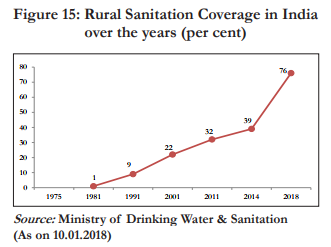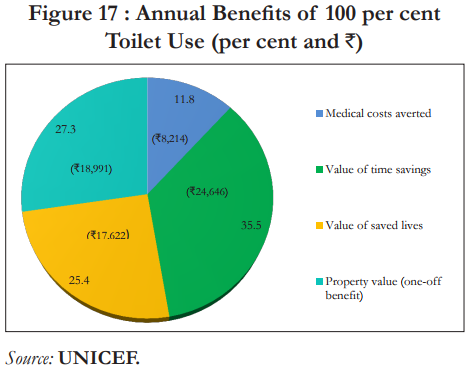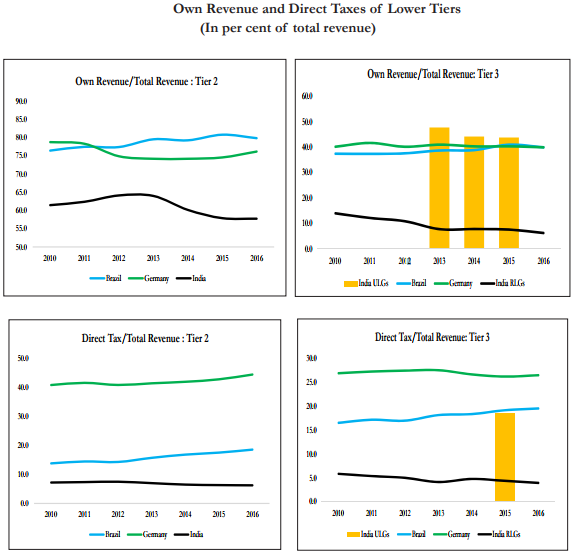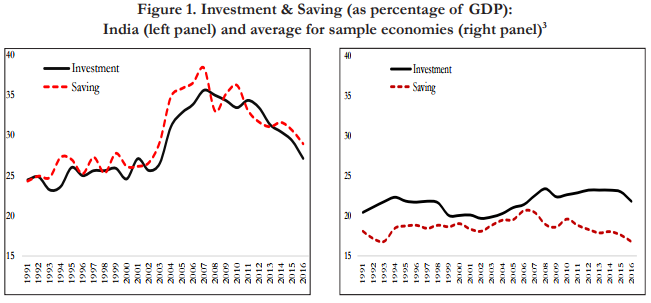Click here for Part III
What to look for?
- Health
- Sanitation
- Fiscal Federalism
- Financial Savings And Investment
- Science & Technology
- Net Producer Of Knowledge
- 'Late Converger Stall'
HEALTH
- The Survey reiterates India’s commitment to achieve the targets under Sustainable Development Goals-3 (SDG-3).
- Some of the goals are aligned with the National Health Policy 2017.
- The Policy recommends increasing State sector health spending to more than 8% of the States’ Government Budget by 2020.
- Strengthening health delivery systems and achieving universal health coverage are the objectives.
- Expenditure - Government healthcare providers accounted for about 23% of the Current Health Expenditure (CHE).
- This reflects the prominence of private hospitals and clinics among health care providers.
- OoPE - Out of Pocket Expenditure (OoPE) has declined approximately 7 percentage points during 2004-05 to 2014-15.
- However, its share is still around 62% in total health expenditure.
- The higher levels of Out of Pocket Expenditure (OoPE) on health adversely impact the poorer sections and widen then inequalities.
- Lack of affordable diagnostic facilities consumes a significant part OoPE.
- Average prices of diagnostic tests widely vary across cities, despite government's efforts to regulate prices of Drugs and Diagnostics.
- DALYs - The concept of Disability Adjusted Life Years (DALYs) helps analyse the disease burden and associated risk factors.
- It is the sum of years of potential life lost due to premature mortality and the years of productive life lost due to disability.
- The Survey advocates understanding the efficiency of public spending with respect to DALYs behaviour across major States.
- This is to assess whether high spending by States on health results in better health outcomes.
- LEB - There has been significant improvement in the health status of individuals in India.
- Evidently, life expectancy at birth has increased by 10 years during the period from 1990 to 2015.
- States with higher life expectancy are reflecting lower DALYs rates i.e. lower incidence of diseases and vice-versa.
- Risk factors - Malnutrition still remains the most important risk factor, despite the drop in rate from 1990.
- Integrated Child Development Services, Pradhan Mantri Matru Vandana Yojana, National Nutrition Mission are efforts at addressing this.
- The contribution of air pollution to disease burden is high in India with levels of exposure remaining among the highest in the world.
- Pradhan Mantri Ujjwala Yojana is a measure in this regard.
- The other key risk factors include dietary risks, high blood pressure and diabetes etc.
- The Survey points to a shift in disease burden from Communicable Diseases to Non-Communicable Diseases over last two decades.
- Way Ahead - The disease burden can be reduced substantially, if the risk factors related to health loss are addressed effectively.
- Also, ensuring the efficiency in use of resources towards health care is essential to translate expenditure into improved outcomes.
- In this context, the increase in use of antibiotics and resultant Antimicrobial resistance is a cause for concern.
SANITATION
- The Survey asserts the importance of quality of hygiene and sanitation for improving the health outcomes.
- Coverage - Sanitation coverage in rural India is stated to have increased from 39% in 2014 to 76% in January, 2018.
- It is mainly attributed to Swachh Bharat Mission (SBM) (Gramin) launched in 2014.

- ODF - The number of persons defecating in open in rural areas has significantly declined, creating positive health and economic impact.
- So far, 296 districts and around 3 lakh villages all over India have been declared Open Defecation Free (ODF).
- 8 states (Sikkim, Himachal Pradesh, Kerala, Haryana, Uttarakhand, Chhattisgarh, Arunachal Pradesh, Gujarat) are declared ODF completely.
- 2 Union Territories (Daman & Diu and Chandigarh) also join this category.
- The NSSO and Quality Council of India's surveys reported more than 90% of individuals, who have access to toilets, using them.
- UNICEF report, ‘The Financial and Economic Impact of SBM in India’, estimated that a household in an ODF village saves Rs 50,000/- a year.

FISCAL FEDERALISM
Concern
- RLGs - The Survey highlights the low level of tax collections by the Rural Local Governments in India.
- RLGs received about 95% of their revenues from the devolved funds from the Centre/State.
- RLGs in India generate only about 6% of revenues from own resources compared to 40% in Brazil and Germany.
- ULGs - On the other hand, the urban local governments generate 44% of their total revenue from own sources.
- ULGs also collect 18% of total revenues from direct taxes, much closer to International norms.
- This highlights the difference in fiscal empowerment between urban local governments and rural local governments in India.
- Direct Taxes - Direct Taxes account for only about 35% in India as against 70% in Europe.
- Indian States generate only about 6% of their revenue from direct taxes as against 19% and 44% in Brazil and Germany respectively.
- Moreover, unlike in other countries, reliance on direct taxes in India seems to be declining.
- This trend will only be reinforced if GST proves to be a buoyant source of revenue.
- Development - Economic and political development has been associated with a rising share of direct taxes in total taxes.
- When countries rely on non-tax sources of government revenues, economic and institutional development could remain stunted.

Cause
- Some State Governments have not devolved enough taxation powers to the Panchayats.
- Notably, permissible taxes for Panchayats include Property and Entertainment Taxes but not Land Taxes or Tolls on roads.
- Even in cases where more powers are devolved, land revenue collection remained low.
- This is due to low base values applied to properties and also low rates of taxes levied.
- Other reasons that the Economic Survey suspects are
- unwillingness to tax by the state, possibly due to close proximity between the state and the citizens
- unwillingness by abled citizens to pay because of dissatisfaction with the quality of services they are receiving
- Centre and States' desire to use their devolution powers to control lower levels of government
Suggestion
- Low tax collections at lower levels are certainly posing a challenge in reconciling fiscal federalism and accountability.
- The Survey calls for better data and evidence to evaluate the impact of 73rd and 74th Constitutional Amendments.
- This is to assess the fiscal empowerment of Rural and Urban local governments, India’s federal structure, its governance and accountability.
- The Survey emphasized the importance of fiscal decentralization.
- Fiscal decentralization is grounded on the idea that spending and tax decisions must reflect local preferences as far as possible.
- This is essential to address the issue of low tier governments remaining stuck in a 'low equilibrium trap' depending largely on outside resources.
FINANCIAL SAVINGS AND INVESTMENT
- India witnessed an unprecedented climb to historic high levels of investment and saving rates in the mid-2000s.
- However, this has been followed by a gradual decline and slowdown still continues.
- Savings - The ratio of domestic saving to GDP fell from the peak 38.3% in 2007 to about 29% in 2016.
- Investment - In India, the investment slowdown started in 2012.
- There is an overall investment decline of the 6.3 percentage points over 2007-08 and 2015-16.
- Out of this, the private investment accounts for 5 percentage points.

- Trend in India- The current slowdown where both investment and saving have slumped is the first in India’s history.
- India’s current investment/saving slowdown episode has been lengthy compared to other cases and it still continues.
- The cumulative fall over 2007 and 2016 has been milder for investment than saving.
- However, India’s investment slowdown is unusual.
- It is so far relatively moderate in magnitude, long in duration, and started from a relatively high peak rate of 36% of GDP.
- Moreover, it has a specific nature, in that it is a balance sheet-related slowdown indicating financial stress of companies.
- Response - Policy priorities over the short run focused on mobilizing the locked up savings.
- This was through attempts like unearthing the black money and encouraging the conversion of gold into financial saving.
- Need - The share of financial saving is already rising in aggregate household saving.
- There is a clear shift visible towards market instruments, largely driven by demonetization.
- The concern is that, investment slowdowns are more detrimental to growth than savings slowdown.
- So, given the changing trend in savings side through recent measures, the need now is to focus more on investment revival.
- Suggestion - The policy conclusion is urgent prioritization of investment revival to arrest the more lasting growth impacts.
- This is essential for India to move towards 8-10% growth.
SCIENCE & TECHNOLOGY
- The Survey records transformation of Indian Science & Technology in the last one year in the outputs.
- Publications - In 2013, India ranked 6th in the world in scientific publications and its ranking has been increasing as well.
- The growth of annual publications between 2009 and 2014 was almost 14%.
- This growth increased India’s share in global publications from 3.1 % in 2009 to 4.4 % in 2014.
- Broadly, the publication trends reveal that India is gradually improving its performance.
- In addition to increasing publications, trends in quality are also stated to be slowly improving.
- The Nature Index that assesses counts of high-quality research outputs ranked India at 13 in 2017.
- Patents - According to the WIPO, India has the world’s 7th largest Patent Filing Office.
- However, India produces fewer patents per capita.
- One major challenge in India has been the domestic patent system.
- While India’s patent applications and grants have grown rapidly in foreign jurisdictions, the same is not true at home.
- Indian residents were granted over 5000 patents in foreign offices in 2015.
- But the number of resident filings in India was little over 800.
- Residential applications have increased substantially since India joined the international patent regime in 2005.
- However, the number of patents granted fell sharply post-2008 and has remained low.
- Measures - The government has recently hired over 450 additional patent examiners.
- It has also created an expedited filing system for Indian residents in 2017, which are welcome interventions.
- Beyond patent filing side, addressing patent litigation issues will be crucial to ensure patent system effectively rewards innovation.
NET PRODUCER OF KNOWLEDGE
- The Survey calls for the need to gradually move from being a net consumer of knowledge to becoming a net producer.
- There is a sluggish pace and expansion of scientific research and knowledge on the one hand.
- On the other hand, generally higher importance is given to careers in engineering, medicine, management and government jobs.
- India thus needs to rekindle the excitement and purpose that would attract more young people to scientific enterprise.
- Laying this knowledge foundation is essential to address some of India’s most pressing development challenges.
- Investing in science is also fundamental to India’s security:
- the human security of its populations
- national security challenges from emerging threats ranging from cyber warfare to autonomous military systems
- the resilience to address the multiple uncertainties due to climate change
LATE CONVERGER STALL
- What - The present era is one of 'economic convergence'.
- It is a condition where the poorer countries have grown faster than richer countries and closed the gap in standards of living.
- E.g. India moved from being a low income country in 1960 to a lower middle income country in 2008.
- It is now attempting to make a transition to middle income status.
- Notably, India is one among the countries that are trying to make this transition after the global financial crisis (2008).
- There are now apprehensions that this process of convergence may slow down for the 'late converger' countries like India.
- This is termed as the fear of "late converger stall".
- Challenges - The Survey notes that India needs to take on four challenges to ward off this fear.
- The four challenges in the process of economic development are:
- the backlash against globalization which reduces exporting opportunities
- the difficulties of structural transformation of transferring resources from low productivity to higher productivity sectors
- upgrading human capital to the demands of a technology-intensive workplace
- coping with climate change-induced agricultural stress
- Globalisation - Some 'early convergers' were able to post average export growth rates of over 15% for 30 years of their convergence periods.
- These include the countries like Japan, South Korea and China.
- However, a backlash in advanced countries against rapid globalization has led to a fall in world trade GDP ratios since 2011.
- This means a decline in exporting opportunities.
- Thus the advantage of favourable trading environment that early convergers had has begun to reverse.
- This could be a challenge for the late convergers like India.
- Structural Transformation - There is a difference in correlation between overall growth and 'good growth' between the early and late convergers.
- Dynamic sectors are those with high levels of productivity and potential for unconditional convergence.
- Good growth comprises growth accounted for by labour share shifts into these good sectors and their productivity growth.
- In this context, manufacturing is a critically important sector for ensuring a desired, successful transformation.
- However, “premature de-industrialization” is the scenario with manufacturing in many late convergers.
- The tendency for late convergers in manufacturing is to peak at lower levels of activity and earlier in the development process.
- This is a cause for concern.
- Because the shift is from informal, low productivity sectors to sectors that are only marginally less formal and only marginally more productive.
- This is a case of “thwarted structural transformation” which India needs to reckon with.
- Upgrading human capital - Late convergers like India have failed to provide even the basic education necessary for structural transformation.
- Evidently, in India, roughly 40 to 50% of rural children in grades 3 to 8 cannot meet the basic learning standards.
- Technology-intensive workplace will increasingly favour skilled human capital in the coming years.
- However, given the skilling shortfall, human capital frontier for the new structural transformation will shift further away.
- There is, however, some optimism that the trend has started to improve since 2014.
- Climate change - Growth rates of agricultural productivity for richer countries have been consistently greater than for developing countries.
- For India, agricultural productivity growth has been stagnant, averaging roughly 3% over the last 30 years.
- India is also vulnerable to temperature increase and still heavily dependent on rainfall.
- For late convergers, agricultural productivity is critical for feeding the population.
- But more importantly, it is essential in human resource aspect.
- This is given the transfer of human resource from agriculture to the modern sectors.
- Also, improving agricultural productivity is a key to achieving sustainable growth, given climate change and water scarcity.
- The Survey concludes that as of now India may not be faced with a “Late Converger Stall”, but need to act in time to ward it off.
Source: PIB